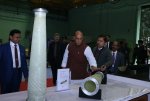HAL, Wipro ink pact for 3D printing in aerospace
By Chethan Kumar| TNN | Jan 2, 2020, 15:19 IST

BENGALURU: In a first, defence PSU Hindustan Aeronautics Limited (HAL), and Wipro 3D, the metal additive manufacturing business of Wipro Infrastructure Engineering, have signed an MoU to design, develop, manufacture and repair of aerospace components using metal additive technology.
The agreement, HAL said on Thursday, accentuates development, prove out and application of new material for use in metal additive technology.
“The path breaking initiative will focus on development and production of aerospace applications including MRO (maintenance, repair and overhaul), using metal additive manufacturing. Prove-outs and certification of components developed using metal 3D printing is also a key element of this co-operation,” a statement issued in Bengaluru read.
Shekhar Shrivastava, CEO, Bangalore Complex, HAL, said that the initiative between HAL and Wipro 3D will create a unique synergy of capabilities that can accelerate the adoption of metal additive manufacturing in Aerospace in India.
“Qualification of parts for aerospace is challenging as it would require prove out and extensive testing followed by certification by regulatory authorities which may also include flight testing. This cooperation would be a unique opportunity for both the parties and metal 3D printing has the potential to play a significant role in the success of national aerospace and defense platforms including HAL’s own needs,” he said.
Globally, the aerospace industry has been one of the foremost adopters of metal 3D printing due to the benefits of faster design iterations, weight and geometry optimization, performance improvement and flexible manufacturing.
Pratik Kumar, CEO, WIN, said, “This MoU will bring Metal 3D printing into the mainstream of India’s aerospace. Wipro 3D and HAL have worked together in the past, and this further strengthens our collaborative efforts to create additive technology leadership in Aerospace.”
Ajay Parikh, vice-president & business head, Wipro 3D, said that the MoU will provide significant manufacturing and MRO flexibility and freedom to existing, upcoming, and legacy aerospace programmes.
HAL, Wipro ink pact for 3D printing in aerospace - Times of India
By Chethan Kumar| TNN | Jan 2, 2020, 15:19 IST

BENGALURU: In a first, defence PSU Hindustan Aeronautics Limited (HAL), and Wipro 3D, the metal additive manufacturing business of Wipro Infrastructure Engineering, have signed an MoU to design, develop, manufacture and repair of aerospace components using metal additive technology.
The agreement, HAL said on Thursday, accentuates development, prove out and application of new material for use in metal additive technology.
“The path breaking initiative will focus on development and production of aerospace applications including MRO (maintenance, repair and overhaul), using metal additive manufacturing. Prove-outs and certification of components developed using metal 3D printing is also a key element of this co-operation,” a statement issued in Bengaluru read.
Shekhar Shrivastava, CEO, Bangalore Complex, HAL, said that the initiative between HAL and Wipro 3D will create a unique synergy of capabilities that can accelerate the adoption of metal additive manufacturing in Aerospace in India.
“Qualification of parts for aerospace is challenging as it would require prove out and extensive testing followed by certification by regulatory authorities which may also include flight testing. This cooperation would be a unique opportunity for both the parties and metal 3D printing has the potential to play a significant role in the success of national aerospace and defense platforms including HAL’s own needs,” he said.
Globally, the aerospace industry has been one of the foremost adopters of metal 3D printing due to the benefits of faster design iterations, weight and geometry optimization, performance improvement and flexible manufacturing.
Pratik Kumar, CEO, WIN, said, “This MoU will bring Metal 3D printing into the mainstream of India’s aerospace. Wipro 3D and HAL have worked together in the past, and this further strengthens our collaborative efforts to create additive technology leadership in Aerospace.”
Ajay Parikh, vice-president & business head, Wipro 3D, said that the MoU will provide significant manufacturing and MRO flexibility and freedom to existing, upcoming, and legacy aerospace programmes.
HAL, Wipro ink pact for 3D printing in aerospace - Times of India

















